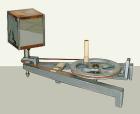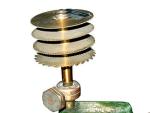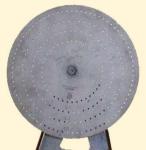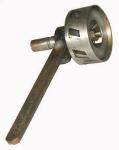 Menu
Menu
|
Function To show the modes of a vibrant plate. |
 | ||
|
|||
|
Description It is formed by a chuck to be fixed onto a table. The glass or brass (circular or square) plates are fixed to the chuck in the centre, between two fibre bearings. We spread the plate with cork-oak filing and we rub the plate on the edge with a violin bow. The plate produces a sound and the nodal figures can be seen. We can modify these lines by touching the plate on the edge and by changing the place where it is rubbed. | |||
|
Function To use with the manometric capsule. |

| ||
|
|||
|
Description The four flat mirrors are held by a prismatic frame of mahogany wood, rotating on its own axe and ending ends with a cone. The mirror are fixed with four strips of brass at right angles and fixed with screws. A great speed of rotation is not required to observer virtual images of the vibrant flames, and in certain case it is enough to move the frame with hand. If the mirror is very close, it is convenient to shield the flame from the air currents caused by the motion of the mirror with a glass plane. | |||
|
Function It produces sounds tuned one with the other. |

| ||
|
|||
|
Description Also this apparatus is an accessory of the rotary apparatus. It is formed by four brass disks with pointed isosceles gear teeth in numbers of 80, 60, 50, 40, fitted on the same axe that ends with a cone. If the wheels rotate with a uniform motion, by drawing a thin cardboard near the gear teeth, we have vibrations proportional to the numbers 8, 6, 5, 4 and the corresponding sounds are perfectly tuned. | |||
|
Function If the speed of rotation is constant we obtain a perfect tune between the emitted sounds. |

| ||
|
|||
|
Description If is formed by a disk of aluminium with a set of four holes in number of 80, 60, 50, 40, corresponding to the perfect tune. After applying the siren to the axe of the rotary apparatus, we make it to rotate with constant speed, and we aim a powerful flow of air at the holes. | |||
|
Function We can obtain sound with different frequencies. |

| ||
|
|||
|
Description Model with revolution counter spring start and stop instantaneously. To keep the sound pitch given by the siren constant, it is necessary to have bellows with a pressure regulator. The number of complete vibrations, that corresponds to the emitted sound, is given by the product of the number of the holes by the number of the turns divided by the duration of the sound in seconds. | |||
|
Function We can obtain sounds of different frequencies. |

| ||
|
|||
|
Description The siren is formed by a disk with nozzles that turns and provoke the emission of sounds that become shriller as the rotation speed increases. With a pivot welded to the disk the siren can be applied to the rotating apparatus. | |||
|
Function Interference of sound waves. |

| ||
|
|||
|
Description The two pipes stay vertically and the one with variable length follows to a guide bearing with a celluloid scale. The annexe accessories (two adapters for rubber tube and two three ways tubes) allow the quick modification of the apparatus for different experiments in interference. | |||